The subtleties of organizing lighting in the corridor
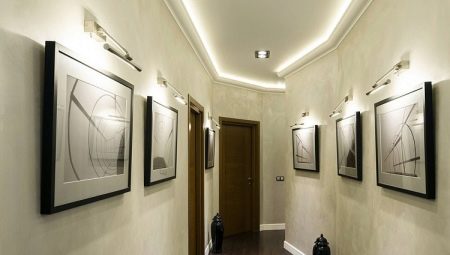
The subtleties of organizing lighting in the corridor are well known to professionals. Even if there is no way to contact designers or electricians, you can make beautiful and individual repairs with maximum functionality. Use the advice of the article or the ready-made solutions presented in the photo.
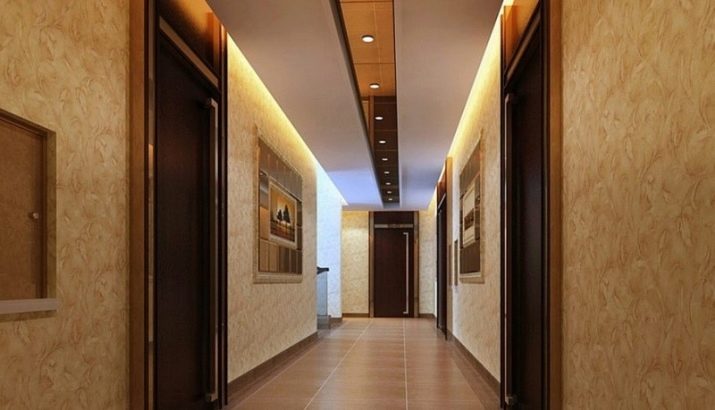
Peculiarities
Each private house or apartment has a hallway or corridor room that connects the front door with other areas of the dwelling. At first glance, this space has a purely definite function, has a minimal set of necessary furniture, and is devoid of natural sunlight. But it is the corridor or hallway that makes the first impression of the dwelling itself, of the tastes and habits of its owners.


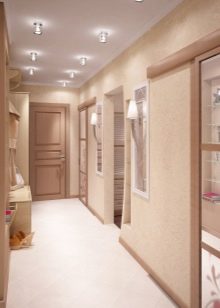
Competently thought-out lighting allows you to visually expand the room, transform the space, make it attractive, functional and comfortable. The correct scheme is able to emphasize the details of the interior, to place the necessary accents on the furniture of the hallway, the external decoration of the room, and its design. Correctly organizing and attractively presenting the space of the corridor is a difficult task, but quite doable.
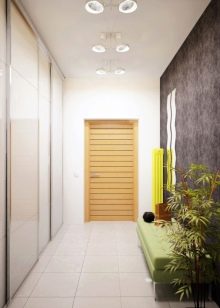

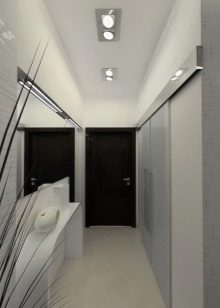
The difficulty lies not only in the absence of windows, but also in the often unsuccessful configuration of the room itself. In modern apartments and private houses, the architecture of the hallway can take different forms - from simple rectangular, square to oval or curved wavy.
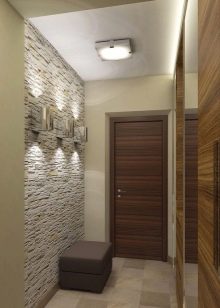
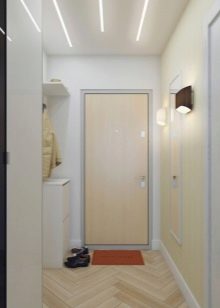

There are several basic rules for organizing the lighting system in the hallway.
- The light emission should spread evenly throughout the entire space of the room. In this case, one chandelier, fixed in the center of the room, is not enough to illuminate every corner of the hallway.
- Light sources with very bright or dim glow are not suitable for corridor decoration. Dim lighting will significantly narrow the space, and bright lighting will cut the eyes and irritate household members.
- Lighting in the corridor should flow smoothly into the lighting of adjacent rooms, a large difference in brightness is undesirable.
- When choosing luminaires, it is best to opt for lamps with a warm matte finish that gently diffuse light.
- The use of energy-saving and LED lighting sources will significantly reduce the consumption of electrical energy; such lighting can be used at any time during the day.
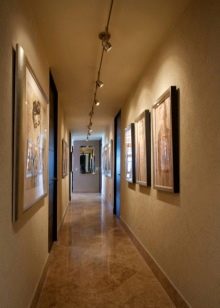
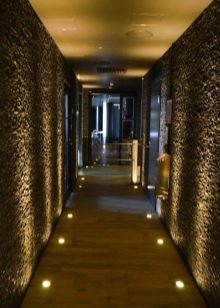

Lighting types
The type of lighting in the hallway must correspond to its geometric shape, footage, interior design, and other features of the room. The main lighting options are as follows.
- Primary or general lighting - mandatory in any case. The main task of this option is to create a comfortable environment when people are in the corridor, which excludes accidental injury, breakage of furniture, decorative elements. To do this, it is best to use one or more chandeliers mounted on the ceiling, ceiling lamps with spotlights, floor lamps or wall sconces built into the wall.
- Local lighting - an integral part of any hallway with a complex architectural form. The light, localized in certain places, emphasizes the original geometry of the room, focuses on individual elements of decoration or decor. For this purpose, it is better to use sconces mounted on the wall, portable lamps with a clip, and other lighting fixtures with a directed luminous flux.
- Additional lighting. Most often it has a decorative function. Additional light allows you to fully reveal the individuality of the room, emphasize its unique features, original design, draws attention to decoration and furniture.
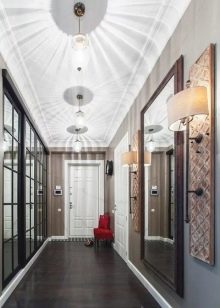

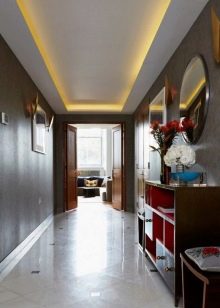
Designers advise combining several lighting options at once in the hallway-corridor.
The combination of various light sources will help to fully use all the functionality of the room, as well as create a harmonious comfortable space.
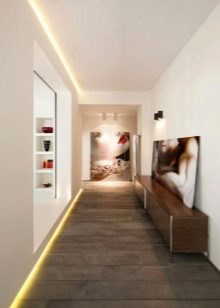
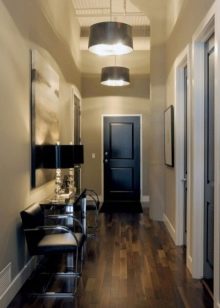
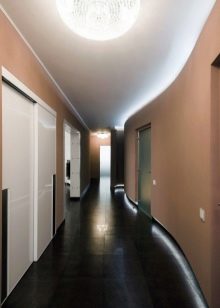
The main
The corridor and hallway have a common negative feature - they lack a source of natural sunlight. If in a private house the entrance hall sometimes has a small window or several windows, then in the apartment, due to the peculiarities of the layout, there is no natural source of light at all. In this case, there is a natural need to use artificial lighting throughout the day. The most popular primary lighting sources include the following.
- Laconic, classic-style chandeliers that are mounted on the ceiling... Such a light source should have a modest decor, without a lot of hanging elements.
- Point light sources significantly save space, they can be placed along the perimeter of the ceiling or in a chaotic manner. The presence of spotlights in the hallway enlivens the overall interior of the room, creates an original shimmering inimitable design. But this type of lighting has a significant drawback - point light can only be installed in stretch or suspended ceilings.
- Spot - a universal lighting device that combines a chandelier and spot devices. The luminaire consists of several lighting devices, the light radiation of which can be directed in different directions.
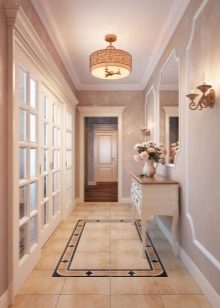
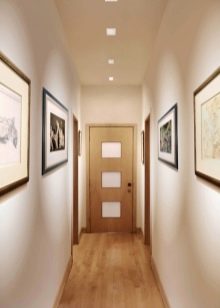
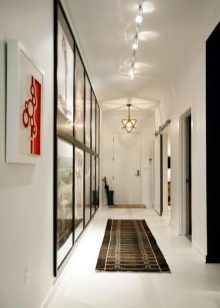
In some cases, wall sconces or a long-stemmed floor lamp are used as the main source of lighting.
Local
Local lighting is designed for the convenience and comfort of the home owners. It is a natural necessity to localize light in certain places in the hallway-hallway (to highlight a mirror, paintings, decorative elements, a curbstone-bench, a wardrobe). With the help of such lighting, you can divide the room into zones, which is also convenient. Such lighting can be organized using various lighting devices:
- sconces, floor lamps mounted on the wall;
- LED and neon strips;
- any light sources with a directed light flux to a specific point.


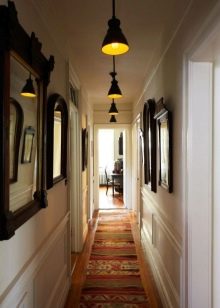
Additional
Additional lighting allows you to focus on the original design of the room, gives the interior a special charm and chic. For such lighting, you need to choose lamps with a matte soft luminous flux. You can organize decorative lighting using the following options.
- An original transparent or matt type suspended from the ceiling, behind which the ceiling lighting can be hidden.
- The simplest and most accessible type of decorative lighting is a backlight hidden in the ceiling plinth, or launched around the entire perimeter of the ceiling on top of it.
- LED and neon strips can be used to illuminate the floor. This type of lighting significantly expands the space of the room, ensures safe movement.
- Spotlights installed in the floor or just above it along the entire wall allow them to be used throughout the night. For such lighting, it is better to use small platforms with a matte light stream.
- Imitation of windows is very important in the absence of natural light sources. In this case, a small niche is formed in the wall, into which light sources are built, as close as possible to natural light.

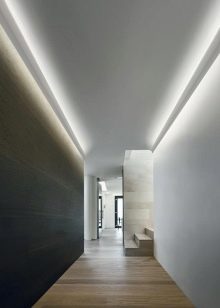
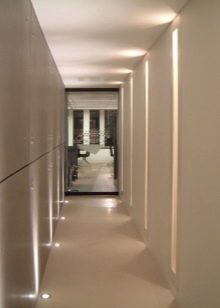
One or more standby lighting devices can be used to illuminate the room at night.
Light as a means of corridor correction
Sooner or later, each owner of an apartment or private house faces the question: how to correctly build a lighting scenario in the hallway, in order to hide the flaws of the room and reveal its advantages. In an apartment with a narrow hallway, it is better to place light sources in such a way that their luminous flux is directed to the ceiling or the upper part of the walls. This technique significantly expands the space, and the corridor visually no longer seems so narrow.
Also in long and narrow spaces good use of halogen spots, the design of which allows you to adjust the luminous flux in different directions. Such lighting fills the room with volume, visually expands it. In a small curved corridor, in addition to the main type of lighting, it is good to use LED strips around the entire perimeter of the ceiling and floor, as well as spotlights. In the house, in the absence of natural light sources in the hallway, you can use several lighting options at once.
Well-placed lighting fixtures will harmoniously combine with each other, providing a comfortable stay in the corridor.

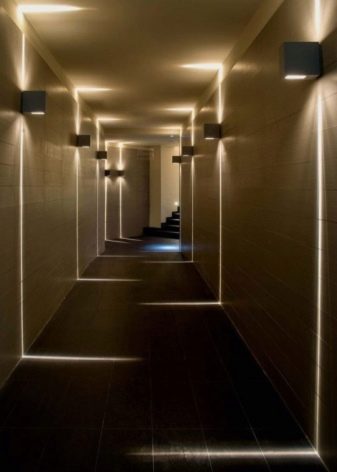
Color and design
The color and stylistic design of the hallway corridor largely depends on the footage of the room and its shape. When decorating a space, it is necessary to take into account the correspondence of the color palette to a particular style of interior.
- Minimalism - excludes the use of bright, catchy colors, it is characterized by light pastel colors, modest decor, the use of natural materials that are ideally combined with ceiling and wall lighting.

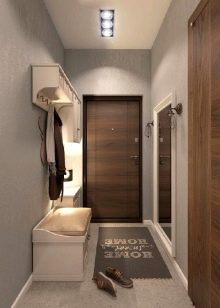

- Modern high-tech style Are silver, glass and metal. This style involves the use of monotonous lighting, framed in strict metal structures, on high legs from floor to ceiling.
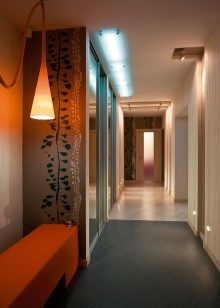
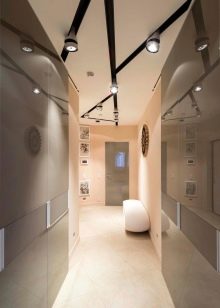

- Pop Art - bright colorful lighting, a ceiling chandelier made of multi-colored lamps and a bright LED strip will decorate the interior of the room.
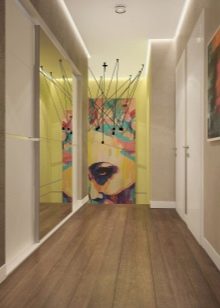
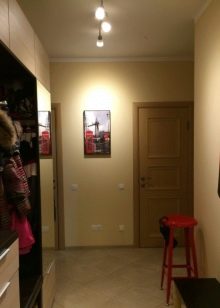
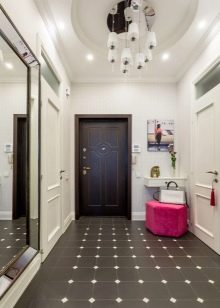
- Classic - the most demanded interior style. Austere laconic wall sconces, a beautiful floor lamp on a long wooden leg, a crystal ceiling chandelier, forged decorative elements, a brown or sand color palette will decorate and ennoble the hallway.

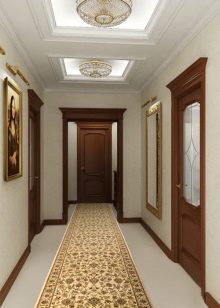
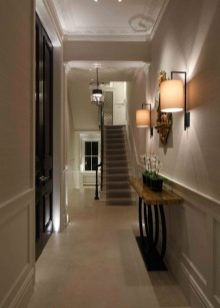
- Empire style does not tolerate halftones and pastel shades. Red, gold, silver colors accentuate individual elements of decor and decoration. Beautiful exquisite lamps with gentle blue light will harmoniously fit into the interior.
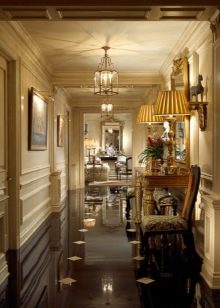
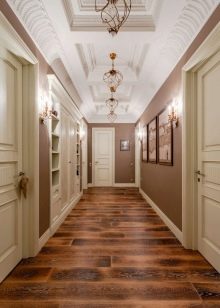
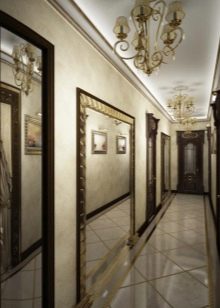
Choice of lighting fixtures
Each lighting fixture has a specific function. When choosing lighting, you need to clearly understand what effect you want to achieve. Spot lighting is good for zoning a room; it is used to illuminate certain places in the hallway and furnishings.
LED strip is indispensable for corridors with complex geometric configurations, winding or undulating rooms, as well as for lighting at night. Luminaires built into furniture allow you to use them throughout the day or at a certain time when such lighting is needed.
Such lighting does not take up extra space, it is convenient to use.

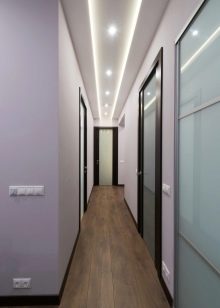
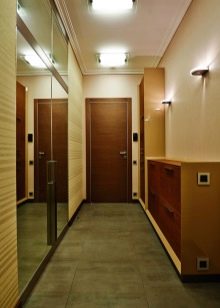
Accommodation options
With stretch ceilings, it is better to use point light sources located around the entire perimeter of the ceiling. The spot light can be installed in the floor along the entire corridor. The location of luminaires with a motion sensor along the walls closer to the floor will automatically control the lighting, react sensitively to any movement, independently switching on and off. Such lighting greatly facilitates the life of the household members of the apartment.
Tape with LEDs and neons is good for framing and highlighting individual surfaces (perimeter of the ceiling or floor, around the mirror, false windows). Wall sconces placed on both sides of the mirror will increase its reflectivity, visually the room will become larger.

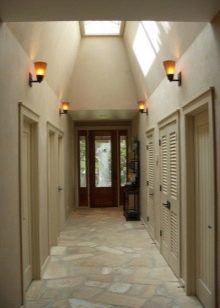
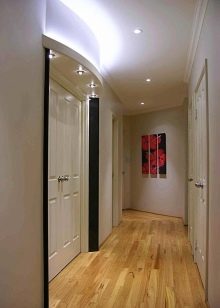
Frequent mistakes
When organizing a lighting system, many apartment owners make the following mistakes:
- a large number of lighting sources that do not fit well with each other;
- the wrong choice of lighting devices (without taking into account the size of the room and its shape);
- wrong choice of place for lamps;
- insufficient number of light sources or their wrong location.
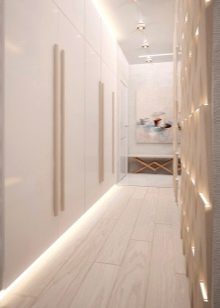
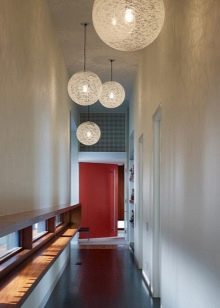
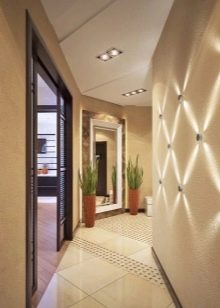
Successful examples in the interior
- For a hallway in the style of minimalism, lamps that are simple in shape are suitable.
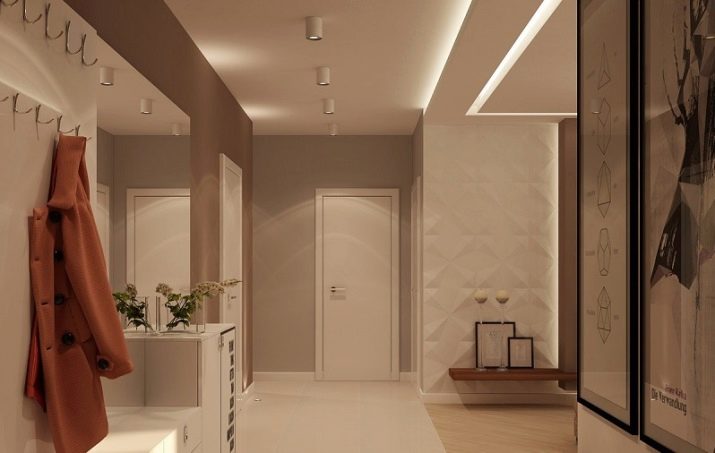
- Lamps can be used to create unusual visual effects.
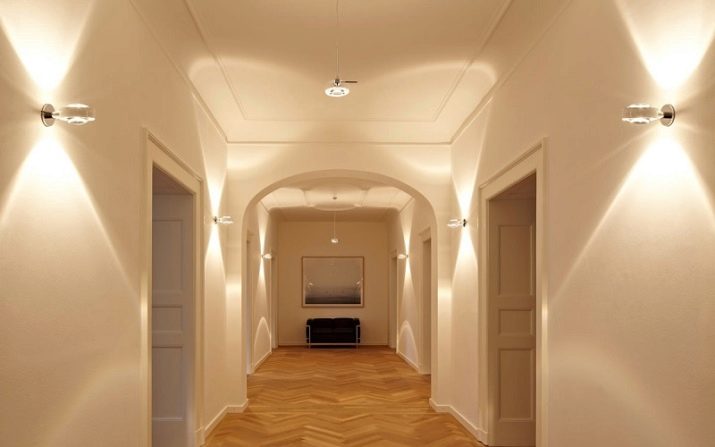
- Visually expanding the long and narrow hallway will help spots on a movable leg, allowing you to change the direction of the light flux.
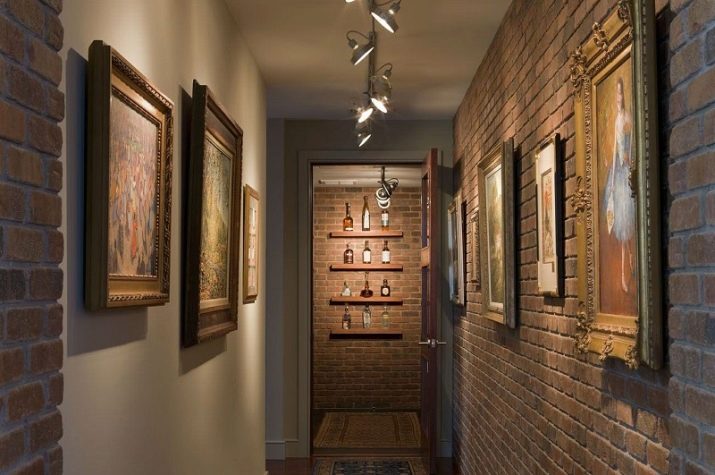
- Competently arranged lighting of the corridor smoothly flows into adjacent rooms.

- Light accents at floor level and under the ceiling help to create a more spacious room.

- Spotlights in the false ceiling help create diffused light and a cozy atmosphere.

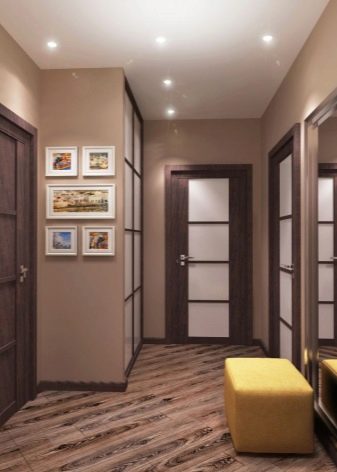
- Point light sources help divide lighting into functional areas.
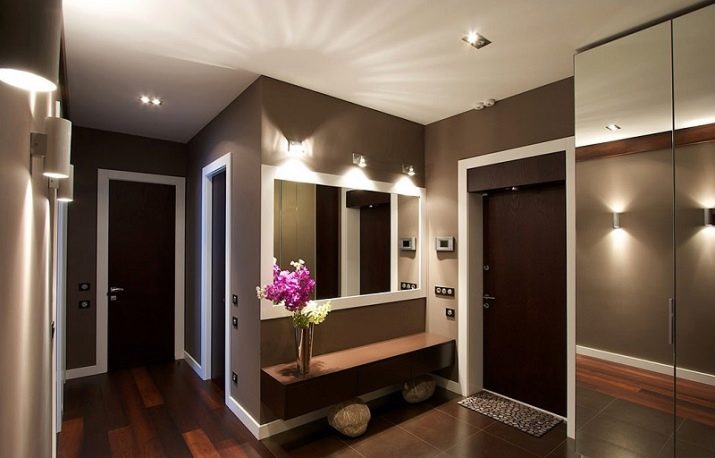
You can find out how to choose a lamp in the hallway by watching the video below.





